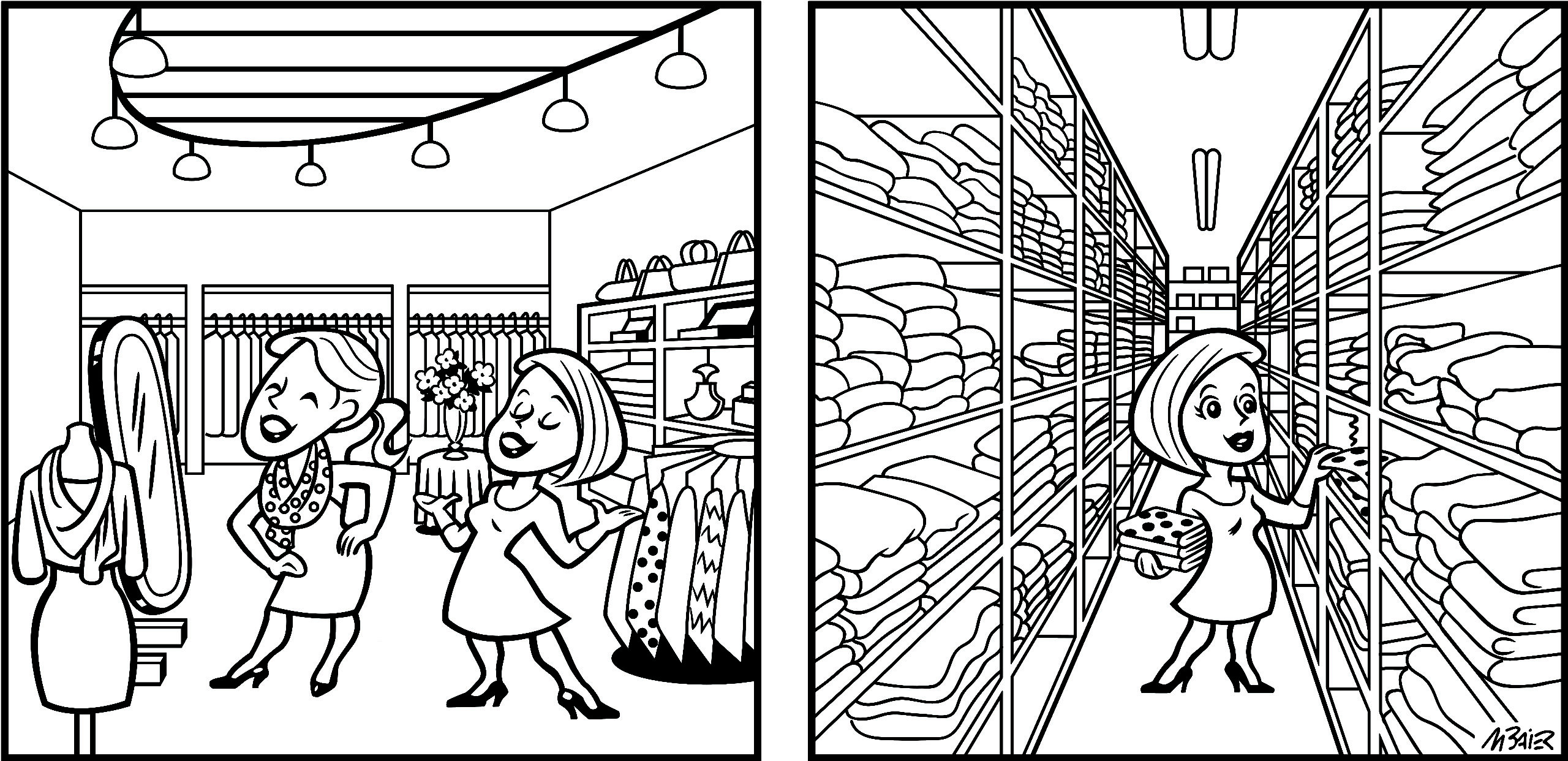The official launch date of my book, “The Circulation Solution,” is this coming Monday the 18th. In the meantime, here is an excerpt from Chapter 2, “Circulation in the Kitchen.” Why is there an illustration of a showroom and a stockroom in a chapter about the kitchen? Read on!
I used up the first example of circulation prevents accumulation already with the dishes, so you might be wondering what is left in the kitchen. The answer? Plenty. There is more built-in storage in the kitchen than in any other room in the home. That means there’s more opportunity to contain excess stuff (i.e. clutter) than anywhere else. Despite this fact, there can be plenty of clutter littering our counters and making it hard to get things done. The kitchen is typically the ultimate gathering place, fulfilling many needs, including, but not limited to, cooking, cleaning, lunch-making, inventory, scheduling, studying, and bill paying. Because purposes are approaching “unlimited,” it’s important to recognize a principle that can be applied to all areas of the office and home, starting with the kitchen.
| “Limitations Breed Freedom” |
The phrase limitations breed freedom sounds like a contradiction, but setting boundaries can actually set you free. This gets back to what I was saying about how organizing comes down to sorting out priorities. If everything is important, then nothing is important. This is particularly crucial to recognize in the kitchen because so many activities tend to happen there, often simultaneously. Placing limitations on the excess items frees you up to act on all these activities. For example, limit the number of items on eye-level shelves and you gain the freedom to quickly find and access the items you use the most.
Set a limitation on what lives on your counter space and you will free up room for food preparation. Setting limitations is essential to ensuring healthy circulation. So how exactly do we go about doing this?
Frequency Merits Facility
The first principle to consider is frequency merits facility. Simply put, the more often you use something, the easier it should be to access.
A great example of this is recycling. You may not like recycling, but it is the law, and it is here to stay. Because it is something we need to do several times a day, it should be super simple. If your current system involves putting on a coat, trudging out to the garage, opening the door, and dropping an empty tuna can in a big recycling bin, then you need a much simpler system. Perhaps you have your grandmother’s tea set, which is rarely used but is sitting on a shelf in the kitchen closet. You may consider this tea set to be far more important than recycling, but because it is used less frequently, it might make sense to give up the tea set’s shelf for a small recycling transport bin or two.
Remember, circulation depends on manageable, reliable stages. Using a convenient recycling transport bin several times a day takes just seconds and because you know it takes just seconds, it becomes a task that you are far more likely to do than trudging out to the garage. It’s manageable and reliable. Emptying this bin once or twice a week into the larger, remote bin in the garage is also manageable and reliable.
Conversely, the less frequently you use something (like the tea set), the more remote its location should be. These items are often less easy to recognize, but the effort to recognize them is well worth it. You might be surprised at how much space can be freed up on critical counters and eye-level shelves by assigning less-used items to more remote storage areas. We will revisit this in future chapters, but this practice is particularly necessary in kitchens.
Entertainment, holiday, and seasonal items all tend to be good candidates for more remote storage. It’s less of a hardship to go to the basement or to upper shelves for these items a few times a year than it is to trudge out to the garage many times a day. Frequency merits facility is one great rule that keeps things circulating freely. Here is another.
Showroom vs. Stockroom
Recognizing the difference between a showroom vs. a stockroom is another rule that ensures circulation. Picture a showroom in, let’s say, a clothing store. It is open, inviting, and well lit. Clothing is generally displayed from eye-level down. There is much activity, but a limited amount of inventory.
Conversely, in the stockroom, you worry less about what it looks like. It tends to be more closed in and you can take more advantage of the vertical space. As a result, there is more inventory and less activity. But here’s the most important thing. Everything in the stockroom space must be reliably findable. It is not a place to hide things away. If you are hiding things from yourself, you should seriously ask yourself, “Why am I keeping them at all?” Things must be reliably findable in the stockroom so that it can support the showroom.
The showroom is designed for the shopper’s convenience while the stockroom is designed for the employees’ limitations. Unless you have a store the size of Costco, you can’t keep the entire inventory on the showroom floor. Most stores are limited by what you can and should keep on the showroom floor. When you go to a box store like Costco, you are usually prepared to spend a longer time to trek through it. If, however, you just want to quickly grab a quart of milk, you are more likely to go to a convenience store. Odds are your kitchen is more like a convenience store or a clothes boutique than a Costco. Our homes are generally designed for both the convenience of a shopper and the limitations of an employee.
In most cases, I do see this distinction between showroom and stockroom in my clients’ homes, but to really benefit from the Circulation Solution, this distinction needs to be pushed further. The reason that it is not more clear may come down to trust. You may not trust that grandma’s tea set will stay dust-free if it goes down to the basement, so you keep it in the kitchen closet where it crowds out the recycling-transit-bin solution. You may not trust that you can find that extra pair of tongs if they go to the basement, so they stay in a utensil drawer, burying that potato peeler you can never find.
By the way, the “stockroom” in your home does not always need to be a remote place like a basement or a garage. It can be your pantry or a top shelf. Showroom vs. Stockroom is ultimately just a theoretical model usedto understand the key distinction between a limited quantity that you need at your fingertips and a larger supply for the items that require less frequent access.
So be like the store owner who is absolutely dependent on finding more medium T-shirts in the stockroom when the medium T-shirts run out on the showroom floor. Remember, things have to be very findable in the stockroom. That’s the reliable part of the equation. You may not have the same accessibility you do in the kitchen (or showroom) but it’s worth making your best effort, which adds to the manageability in this stage of circulation. There will be more information on keeping your storage reliable and manageable in Chapter 6.
Your #1 Organizing Tool
My clients are always asking me what they should buy to stay organized. My answer is pretty boring, but it is at the heart of the Circulation Solution. Your number one organizing tool is a clear work surface for processing. Disappointed? Hear me out.
Let’s go back to my definition of circulation prevents accumulation:
A plan for all the stuff in our lives to move forward in a series of manageable, reliable stages.
Perhaps the most important word in that definition is “move.” A clear surface allows for movement. The more surface space you have to spread out, the easier it is to sort, to prioritize, and to act.
The second most important word is “stages.” For circulation to work, it must work in stages. “Sort,” “prioritize,” and “act” all represent stages. The “act” stage must be followed by flying off the surface to the next stage. It’s helpful to look at your desk, dining table, or kitchen counter as a tool rather than a piece of furniture. Every tool has a purpose. The purpose of a work surface should be for processing. To stay organized, never squander your work surface for storage.
Here’s another way of looking at it. The FedEx airport in Memphis, Tennessee, processes mail from all over the country. Airplanes circulate around the clock, landing, unloading, reloading, and taking off again. The whole system is dependent on planes clearing the runway after landing, so new planes can land. This can’t happen if the mail doesn’t get processed. All these stages must happen. If a plane decides to park on the runway instead of going through the stages, it’s just a matter of time before disaster happens. Your work surfaces are like that runway in Memphis.
***
Recognizing that frequency merits facility, the distinction
between showroom and stockroom, and the importance of reserving work surfaces
for processing will make it easier to choose manageable, reliable stages in the
kitchen. These stages are the essential components to resisting clutter and
staying organized. You will see them again as we continue to other parts of
your home, office, and schedule.
Please Share With Your Community
















